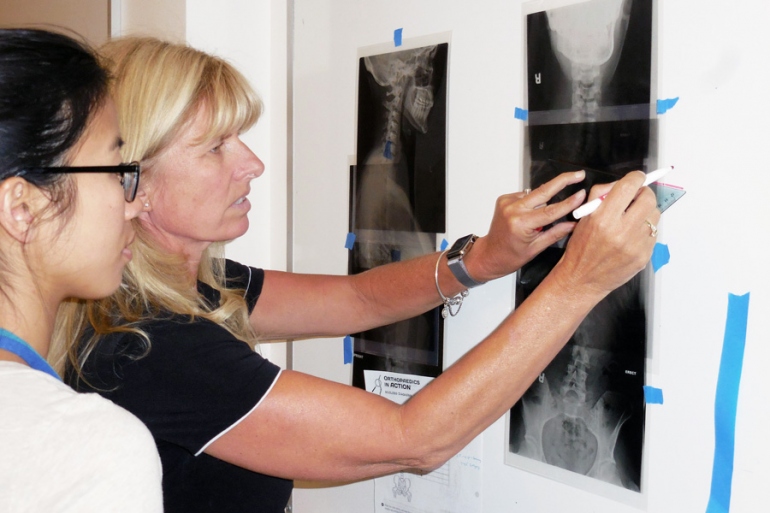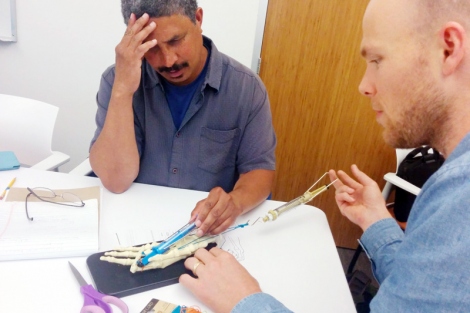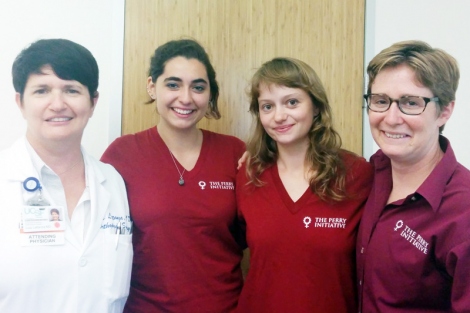Bioengineering Lessons Aim to Inspire Girls to Become Surgeons, Engineers
UCSF Event Offers Teachers Hands-on Curriculum Combining Engineering, Math, Medicine

Perry Initiative volunteer Catherine Chang (left) helps Shelly Davis, a junior high biology teacher from Granite Bay, with a scoliosis diagnosis at a UCSF professional development session. Photo by Nicholas Weiler
Despite all the progress in STEM education for girls, one field that remains among the least represented by women is orthopaedic surgery.
“There’s a bias about what orthopaedic surgeons ought to look like,” said Lisa Lattanza, MD, professor of orthopaedic surgery and chief of hand, elbow and upper extremity surgery at UCSF. “There’s this idea you need to be a big strong brute.”
Perhaps as a result, only 7 percent of orthopaedic surgeons are women nationwide, according to the American Academy of Orthopaedic Surgeons.
In fact, orthopaedics is an exciting blend of both engineering and medicine that many girls just haven’t been exposed to. “A lot of people don’t realize you can combine the two,” said Julia Paganucci, a rising sophomore at the University of Delaware who was first exposed to bioengineering when she attended a daylong workshop in high school.
The workshop was held by The Perry Initiative, a nonprofit founded in 2009 by Lattanza and her friend and colleague Jenni Buckley, PhD, assistant professor of mechanical engineering at the University of Delaware, with the aim of tackling the gender imbalance in their two fields.
The lessons stuck with Paganucci, who is now an intern with The Perry Initiative and thinking of pursuing a career like Buckley’s – engineering orthopaedic implants. This summer, she’s been helping the initiative introduce a new orthopaedics-based science curriculum, called “Orthopaedics in Action,” to science teachers around the country. Last week, the initiative came to UCSF to offer Northern California science teachers a hands-on test of the new curriculum.
The science teachers have all been immersed in helping their schools and districts prepare curricula that meet the new Next Generation Science Standards, which officially take effect for all California schools in 2018. The new standards aim to replace fact-filled lectures with hands-on lessons driven by experimentation and discussion, and grounded in practical applications of science such as engineering.

San Francisco high school biology teachers Kevin Hartzog and Andrew Busch estimate the most efficient grip for a rock-climber clinging to a cliff face using a realistic model of a human hand. Photo by Nicholas Weiler
So far, it’s been hard to find inquiry-based lessons in biology that really connect with students, said Andrew Busch, a biology teacher at the Academy of Arts and Sciences in San Francisco who took part in the UCSF professional development session. “Most of them are either too hard or too easy.” But the Ortho in Action lessons are different, Busch said.
Last week, the teachers worked through six different lesson plans utilizing X-ray photographs and bone and tissue models like those you might see in an orthopaedic surgeon’s office.
In one lesson, the teachers learned the physics behind a runner’s torn Achilles tendon, debated the best stitch to use to repair it, then tested their ideas on a tendon-like bundle of nylon fibers. In another, they used a life-like model of the knee to learn how rubber band-like ligaments keep the joint stable and how to diagnose a soccer player’s knee injury based on a busted joint’s unnatural flexibility.
The narrative of sports medicine and chance to manipulate realistic orthopaedic models were particularly helpful. Busch is pretty familiar with how muscles, tendons and bones work together – he studied physiology in graduate school and was a volleyball player in college – but was still “shocked” by how helpful the hands on lessons were: “Holding these models in my hands and using them to actually diagnose a knee injury – I understand this better after today than I have in 10 years of thinking about this stuff.”
Orthopaedics is a natural way to tie together ideas across biology, engineering and mathematics, according to Buckley, who led Monday’s session.
For instance, she said, in a lesson on diagnosing scoliosis – a common spinal disorder affecting up to 5 percent of adolescents – students must apply geometry to measure the spine’s lateral curvature, then use their knowledge of biology, engineering and the scientific method to decide if a patient should be treated with an orthopaedic brace or corrective surgery.
This lesson is a personal one for Buckley, who is considering surgery for her own scoliosis. In fact, she might get some advice from the students, as her own X-rays are part of the lesson.
“Just like in real life, there’s not necessarily one right answer,” Buckley said. “The point is to generate good discussion in the classroom and empower students to make the best decision they can for their patient.”
Mentorship is key to getting young women excited about engineering, research and medicine, Lattanza said. “Role models are huge. If you don’t see someone who looks like you doing something, you’re probably not going to do it.”

Perry Initiative co-founders Lisa Lattanza, MD (far left), and Jenni Buckley, PhD (far right), pose with interns Julia Paganucci and Gemma Ciabattoni at an Orthopaedics in Action professional development session at UCSF. Photo by Nicholas Weiler
The Perry Initiative is named after Lattanza’s own mentor, renowned orthopaedic surgeon Jacqueline Perry, the first woman to graduate from the UCSF Orthopaedic Surgery Residency Program in 1954. Lattanza was working as a physical therapist in Los Angeles when she met Perry, who advised her to go to medical school. “I didn’t think I was smart enough,” Lattanza said, but Perry’s confidence in her made all the difference.
The Perry Initiative’s daylong bioengineering workshops for high school students now reach 3,500 young women like Paganucci in 47 cities annually. But Buckley and Lattanza realized that the adoption of Next Generation Science Standards by California and a number of other states could be an opportunity to expand these efforts into junior high and high school classrooms. The Perry Initiative teamed up with education experts to develop Orthopaedics In Action with additional support Chevron, and the University of Delaware.
It’s critical to get girls excited about the possibilities of engineering and medicine as early as possible, Lattanza said. “The research shows we lose young women in science at the junior high level,” Lattanza said. “College is way too late.”